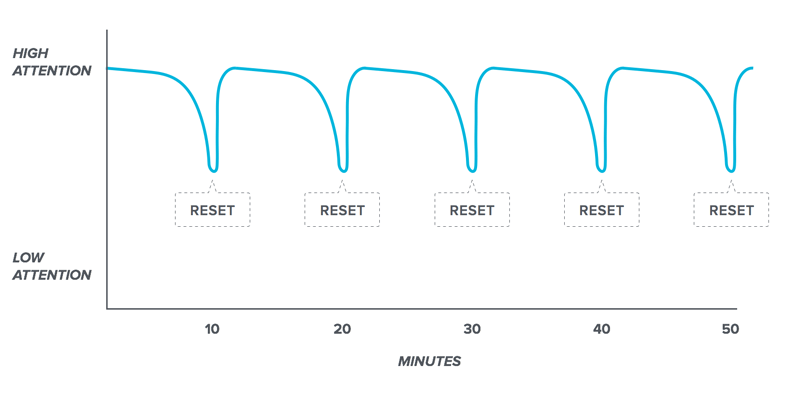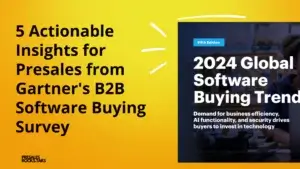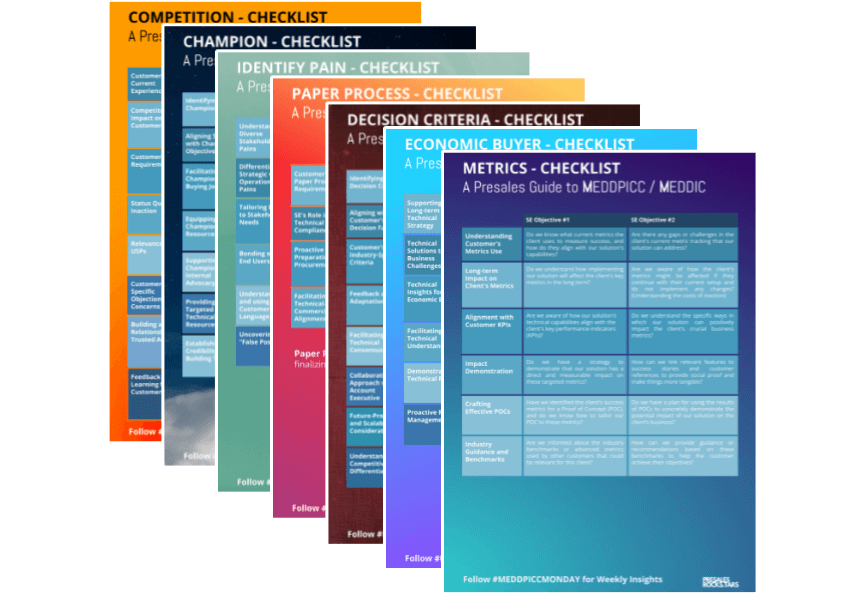Selling B2B-software is not just a battle against your competitors. In our modern society, it is also a battle for your audience’s attention.
The likes of Netflix, Youtube, Spotify and constant smartphone notifications have reduced the average attention span to less than five minutes.
As a result, your audience is having a hard time focusing and concentrating on your demo without feeling the urge to check their phones or emails.
In 1978, James Hartley and Ivor K. Davies conducted some research, examining the attention span of university students during a 50-minutes lecture. And even back in the days when smartphones were nothing but fantasy and the lecturer was standing in front of the students, attention dropped significantly close to zero after the first 10 minutes.

The research by Hartley and Davies is emphasizing the importance of gaining, but especially retaining your audience’s attention during your (web) demo, which has become a critical success factor for winning software demos.
It is quite obvious that you cannot sell your product and value proposition if nobody is listening to you.
And because you are lacking control over your audience in remote demo settings, it is even more important to be aware of the tools and techniques to (re-) engage with your audience in a regular fashion.
In response to the research results from 1978, J. Medina has introduced the 10-minutes rule in his book „Brain Rules“ (2009) in order to actively manage & reset your audience’s attention:

The graphic illustrates the relevance of pushing the „attention reset button“ at least every ten minutes to re-focus your client’s attention.
And since the introduction of the iPhone in 2007, attention did further decrease.
Retaining your audience’s attention is much more than just asking for feedback and questions. It is the way you organize and present your content that makes your demo engaging and your value proposition stick with your prospect.
Only if you apply some of the techniques we are going to discuss in this article, you can increase your chances of providing a winning presales demo and not waste time by speaking into an empty room.
Just pick the tools which best fit your personal demo style and try to incorporate these into your demo step-by-step. It is all about continuously improving your demo performance and learning what works best for you.
#1 Make Them Laugh
I have to admit that this is my favourite way of pushing the reset button. And there is not much out there that is more engaging than a good laugh. Nobody can not pay attention when the rest of the audience is laughing, and we always want to know what is so funny.
The critical caveat is that your humour must be relevant to your demo and message. You do not want to make your demo a comedy show.
Luckily, you do not even have to be super funny. According to Jason Teteak from „Rule the Room Public Speaking“, your audience does not laugh because you are a comedian. They laugh because they like you and feel comfortable in your presence. A little remark can often be enough to re-engage your audience, break the pattern and make them laugh.
FYI: This is also one of the reasons why TV-sitcoms are using laugh tracks to simulate an engaged studio audience. It is proven that their use is accompanied by higher audience ratings and increased retention.
And this is exactly what we want to achieve during our demonstrations (but please do not laugh about your jokes ;)).
#2 Tell a Story
We love listening to stories. We have been hardwired to listen to stories since the stone age to share experiences and knowledge. Stories immediately trigger our brain, engage us and require little effort to stay focused.
The moment you say „Let me tell you a story about a client that…“, your audience will automatically perk up and refocus their attention.
Since complex solution sales is all about stories and context, mastering the art of storytelling is key for successful (pre) sales executives.
Listen carefully to your colleagues, share best practices and stories internally and build your arsenal of anecdotes to use at given times. Once again: be relevant. Nobody cares about what you had for breakfast!
#3 Make a Transition
You might have experienced this yourself in other presentations, lecture or webinars. You may have become distracted for just a few minutes and then found it hard to get back on track with the content that is being presented. As a result, you fully tuned out of the presentation and did not pay any further attention until the very end. (I was once distracted in maths for just about 30 secs and found it impossible to catch up over 7 years…;)).
To avoid a similar scenario in your demo, it is important to consider two things:
- Do not run a marathon; do not hold endless monologues. Instead, cut your demo into short and digestible pieces that will enable your audience to get back on track easily.
- Use transition statements as a clear signal to your audience that they should refocus. Introduce new segments of your demo saying things like „Let me quickly summarize the benefits of this feature before continuing with the next topic on our agenda“.
This will allow your audience to tune in again rather than losing the tread completely.
The Tell-Show-Tell methodology that has been introduced by Demo2Win! is a great framework on how to cut your demo into bite-sized pieces and provide both context and transitions to engage with your audience throughout a longer demo.
#4 Switch Speakers
Ideally, you are always accompanied by a sales executive or partner during your demo. Use this to your advantage and switch between both of you to reset your audience’s attention!
Unless you are a voice artist, people quickly become tired of your voice if you keep going on and on. With your sparring partner, agree on fixed timestamps to hand over the microphone.
If the two of you are more experienced working with each other, things will work automatically.
The moment your audience hears a different voice, their brain is triggered once again to refocus and pay attention.
Please do not just split your demo into the corporate overview and demo part, where sales is doing the intro and you are doing the rest. Switch regularly and show your audience that your AE is also listening while you are talking.
Being silent throughout the demo is a sign of disrespect and shows a lack of interest towards your prospect. You are not going to retain your audience’s attention if your sales guy is disengaged himself.
#5 Blank your Screen
Sometimes you got to change something to interrupt your audience and refocus their attention. Especially if you would like to discuss something important, make a point or get their feedback, it can be super helpful to just blank your screen. It is as easy as pausing your screen sharing.
There are two good reasons why a sudden blank screen can improve your engagement:
- the sudden change to a blank screen will wake them up; they might wonder if something is broken until you carry on with your explanation of the blank screen
- No visual distraction: if you are trying to make a point or summarize a key topic, keep it simple. If you show a slide or anything else, your audience will keep reading what’s written on their screen. Only parts of their brain will listen to your voice. But if you blank out your screen, your audience will pay full attention to what you are saying.
A blank screen does not only reset attention. It is also a nice and easy tool to use to increase your message retention.
#6 Switch your Webcam on & off
To be fair, before COVID-19 I was super hesitant to switch on my webcam. But in my opinion, the willingness to use video has changed significantly over the past months.
Using video enables you to create a much more personal relationship and atmosphere during your demo. It is not like meeting face to face but at least you can look into each other’s eyes for a short while.
Especially during the opening of your demo and the introduction of all audience members, using your webcam will significantly increase your relationship with your audience.
Suddenly, you are much more than this voice (in my case with a horrible German accent) that is coming out of their computer. Being able to see allows your audience to sympathise with you and recreate parts of a physical meeting.
I agree with Peter Cohan from Great Demo! that you should not be using your webcam throughout your demo. Once you start sharing your screen, your webcam can be a huge distraction for your audience.
Instead of looking at your screen, they will keep looking at your face. That’s nice but not the purpose of your demo.
But we can use this again to our advantage and deliberately switch the webcam on again in certain situations. E.g. when summarizing parts of your demo, asking questions to your audience or entering into a discussion, most importantly when agreeing to the next steps.
Even when you blank your screen, switching your webcam on is a nice add-on. It is another transition signal that will tell your audience something important is going to happen – and retain their focus.
#7 Hand over Control
You might have heard of the average learning retention rate that has been published by the National Training Laboratories, Bethel Maine. It illustrates different degrees of message retention induced from various learning techniques.
You can mostly differentiate between passive (reading, listening) and active (practice, teaching) learning methods. The model suggests that most students only remember about 10% of what they read from textbooks, but retain nearly 90% of what they learn through teaching others.
Demonstrations have a retention score of just 30%…
And those figures resulted from an off-line learning environment. We are not even talking about remote scenarios.
On the other hand, a more active learning approach called „Practice by doing“ has a retention rate of 75%. Far beyond the effectiveness of a one-way demonstration.
Luckily, screen sharing and conferencing tools have significantly improved their capabilities of letting your audience take over control of your mouse.
Personally, I’ve been pretty impressed by the capabilities of Demodesk. Unlike other screen sharing tools, Demodesk has been specifically built for selling and demoing SaaS-platforms.
Rather than mirroring and sharing your screen, they provide you with a virtual cloud you and your audience can access from within your Demodesk meeting.
I often felt uncomfortable handing over control of my computer. The experience just was not very smooth and prospects sometimes thought it is our software that is super laggy. When in fact, it was the meeting tool that caused the delay.
By giving control to your audience, you might not get to the 75% retention rate suggested by the National Learning Laboratory. But it is a nice and engaging way to turn your one-way demo into an interactive session.
And I´m 100% sure that some hands-on experience is more memorable than just listening and watching.
#8 Polling & other interactive Tools
One thing that I have recently noticed in the „New Normal“ is the frequent use of polling tools and other interactive features that enable real-time engagement with your audience.
The most prominent ones that come to my mind are Slido and Mentimeter. Before your demo, you can easily prepare some questions and polls and share results in real-time with your audience.
It is a fun and engaging feature, but I have two concerns:
- You need a certain audience size to get meaningful results and engagement. If you are demoing to just two or three people, you do not need interactive polling. Just talk to your audience!
- You are basically asking your audience to pick up their phones. It is the one thing we do not want!
Nevertheless, when demoing to larger audiences, interactive capabilities can drive engagement and generate interesting results.
#9 Take a Mini Break
Especially when doing demos that go beyond 90-minutes, I can highly recommend allowing time for a short break. Say two to three minutes (better plan five minutes ;)) for a bio break or getting a cup of coffee.
You do not have to make that break once you are halfway through the demo and interrupt your demo flow. Wait for a suitable transition as described above to restart with a new topic.
In addition to resetting the attention, your potential clients can also take a few minutes to process the information you have shared. Even if there are no distractions, our brain can only process a certain level of input. And in order to increase your message retention, you do not want to cause a content overflow and dilute your message.
#10 Leverage the Cocktail Party Effect
The Cocktail Party Effect is a phenomenon where the human brain can focus on a single conversation even though the room is full of noisy people.
We have been specifically primed to react to our own name and shift our attention towards known sounds.
The Cocktail Party Effect can easily be applied in your software demo to retain attention. Simply pick up client-specific lingo and use your listeners‘ names on a regular basis.
Your audience will automatically “tune into” your voice and “tune out” all other stimuli around them. Their brain will consider your discussion being the most relevant one by mirroring familiar language and using names.
Summary – The importance of managing attention in remote software demos
In the „New Normal“, managing online presentations and demos effectively has become a key skill to close more business.
This article is about the art of retaining your audience’s attention. Applying some of the techniques will make sure your client is going to listen to you, which is critical to convey our value proposition. It is the first step of mastering web-demonstrations.
In further articles, we will discuss how to organize and present your content to make sure you provide maximum customer value and leave a long-lasting, positive impression with your demo.
If you know any other techniques to push the audience reset button, please feel free to share your thoughts with us.





